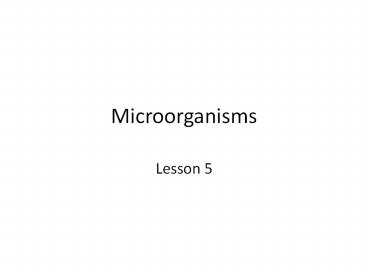Microorganisms - PowerPoint PPT Presentation
1 / 13
Title:
Microorganisms
Description:
Microorganisms are tiny creatures, too small to be seen with just our eyes. ... Yogurt, sour cream and cottage cheese are produced by bacteria. ... – PowerPoint PPT presentation
Number of Views:94
Avg rating:3.0/5.0
Title: Microorganisms
1
Microorganisms
- Lesson 5
2
Microorganisms
- What is a Microorganism?
- Microorganisms are tiny creatures, too small to
be seen with just our eyes. - Microorganisms provide larger organisms with some
of the food and oxygen they need to survive.
3
Studying Microscopic Organisms
- A microscope is an instrument that produces an
enlarged image of an object. - Anton van Leeuwenhoek Dutch merchant used a
microscope to study organisms in the 1600s. - A compound microscope uses two or more lenses and
a light source to magnify objects as much as
2,000 times.
4
Studying Microscopic Organisms
- An electron microscope uses a beam of electrons
rather than a light source to magnify samples. - Electron microscopes cannot be used on living
samples, because the stream of electrons and the
preparation process would kill them.
5
How are microorganisms beneficial?
- Microorganisms are decomposers.
- A decomposer is an organism that breaks down dead
materials into simpler substances. - Decomposers recycle substances that would
otherwise remain useless.
6
Food Production
- Yogurt, sour cream and cottage cheese are
produced by bacteria. - Bacteria also helps improve the flavor of cocoa,
tea and coffee. Even pickles and sauerkraut are
prepared with the help of bacteria.
7
How are microorganisms harmful?
- Some microorganisms are parasitic, meaning they
cause damage to plants and animals. - Some microorganisms make you feel sick, while
others can be deadly.
8
Harmful Microorganisms
- Infectious Disease Some cause disease by
destroying cells directly. (Strep Throat, or
pneumonia) - Bacteria cause disease by producing poisonous
substance toxins (poison). - Bacteria also live in uncooked meats, raw eggs,
and other foods. E. coli and Salmonella are two
of the most well-known. Fever and sore throat
are two examples of symptoms.
9
Harmful Fungi
- Microorganisms can also harm plant life. These
are considered parasites because they live on a
host organism causing harm to it. - In the nineteenth century, a fungus spread
throughout Ireland and destroyed large amounts of
the potato crop, causing thousands to starve. It
was known as the Irish Potato Famine.
10
Harmful Fungi
- Athletes foot is another example of a disease
caused by harmful microscopic fungus. It is
found in damp places and lives on skin. The
symptoms include itching and blisters between a
persons toes.
11
Protists
- Parasitic protists can also cause health problems
in animal species. - Malaria is an example of a parasitic protist.
The protist is spread by the mosquito and then
reproduces inside red blood cells, destroying the
blood cell. When the blood cells are destroyed
new parasites are released into the animal. - Results, severely high fever and the chills.
12
How do we protect ourselves?
- Antibiotics are used to treat bacterial
infections. Antibiotics stop the growth of
bacteria. Antibiotics are produced from bacteria
and molds, and are artificially produced in
labs. - Each antibiotic only works on certain types of
bacteria. - For each new bacterial infection, new antibiotics
must be developed!
13
Food Safety
- Pasteurization is used to ensure the safety of
our food. Heating milk and other liquids to a
high temperature kills the bacteria without
altering the liquid. - Cooking also destroys harmful bacteria in food,
by destroying the bacteria cells. - The government also has food inspectors to ensure
the safety of foods.































